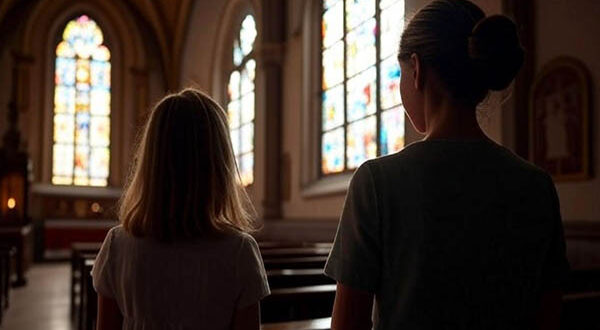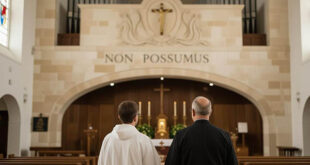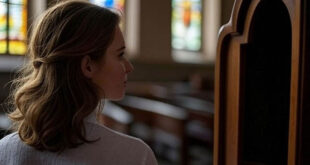A spiritual guide to rediscovering reverence at the heart of Catholic worship
Introduction: Why talk about the sense of the sacred today?
We live in an age where immediacy, technology, and entertainment dominate the emotional and spiritual landscape of younger generations. In this fast-paced and often superficial context, the Church’s liturgy—with its silence, symbolism, sacred language, and orientation toward mystery—appears to many young people as a foreign, even incomprehensible, language. How, then, can we help young people discover the profound value of the sacred? How can we teach them that the liturgy is not a show or a social gathering, but the privileged place of encounter with the living God?
This article seeks to answer these questions from a theological, pastoral, and practical perspective, helping parents, catechists, priests, and the faithful in general to rediscover and transmit the sense of the sacred, especially within the liturgy.
1. What is the sacred?
The term “sacred” comes from the Latin sacer, meaning “consecrated,” “set apart for God.” In biblical thought, the sacred is that which has been touched by God, that which belongs exclusively to Him. In this sense, it is not merely an object or a place, but a reality imbued with the divine presence.
God is the Holy One par excellence. The prophet Isaiah proclaims this in his vision of the heavenly throne:
“Holy, holy, holy is the Lord of hosts; the whole earth is full of his glory.” (Isaiah 6:3)
God’s holiness is not just one of His attributes—it is His very identity. To participate in the sacred is, therefore, to enter into a direct relationship with this thrice-holy God. Thus, throughout the Bible, contact with the sacred requires an attitude of reverence, awe, humility, and even holy fear.
2. The liturgy as sacred space
The liturgy is not a human invention but an action of Christ and His Church. In it, the mystery of salvation is sacramentally made present. It is God Himself who acts, and we are invited to participate in this divine action.
The Second Vatican Council expressed this clearly:
“The liturgy, through which, especially in the divine sacrifice of the Eucharist, the work of our redemption is accomplished, most powerfully enables the faithful to express in their lives and manifest to others the mystery of Christ.” (Sacrosanctum Concilium, 2)
Therefore, the liturgy is not merely “doing religious things,” but entering the realm of Mystery. Every gesture, word, vestment, symbol, and rite has a depth that points to eternity. The altar, the incense, the chant, the silence… everything in the liturgy points to a reality that transcends us and can only be received in faith and reverence.
3. Why have young people lost the sense of the sacred?
This loss is not exclusive to young people. It is part of a broader cultural crisis: secularization has eroded the perception of mystery, and with it, the awareness of the sacred. However, in young people this process is intensified by several factors:
- Superficial or absent religious education: Many young people have not been formed in the doctrinal and liturgical richness of the Catholic faith.
- Banalized liturgical environments: In many parishes, the liturgy has lost its dignity: it is improvised, symbolic language is neglected, silence is sacrificed for spontaneity.
- Influence of digital culture: Accustomed to immediacy, visual stimulation, and emotional impact, young people struggle to appreciate the slow rhythm and dense meaning of the liturgy.
All of this leads to the Mass being perceived as boring or irrelevant, and the sacred as “old-fashioned” or “unnecessary.” Yet what young people need most—though they may not always realize it—is precisely that contact with the transcendent which only the sacred can offer.
4. The theological meaning of liturgical reverence
Reverence in the liturgy is not merely a matter of etiquette or protocol. It has a profound theological foundation: it is an expression of both faith and charity. Whoever believes that Christ is truly present in the Eucharist cannot behave as if they were in a meeting room. Whoever loves the Lord desires to honor Him with their whole being: body, mind, and heart.
As St. Paul says:
“Do you not know that you are God’s temple and that God’s Spirit dwells in you?” (1 Corinthians 3:16)
This reverence is manifested in:
- Modesty in dress, recognizing that one enters the house of God.
- Bodily posture: kneeling, genuflecting, joining hands in prayer.
- Prayerful silence before, during, and after Mass.
- The manner of receiving Holy Communion, with faith and recollection.
- Liturgical language that avoids banality and opens the soul to the sublime.
This is not about rigid rule-following out of fear or habit, but about educating the soul to enter into harmony with the Mystery. The liturgy is “the school of holiness,” as St. John Paul II used to say.
5. How to teach young people liturgical reverence
Teaching reverence is not about imposition, but about awakening desire. It means showing the beauty of the sacred so that the soul hungers for the eternal. Here are some concrete suggestions:
a) Adult witness
Nothing teaches more than an adult who lives their faith with coherence. If young people see their parents, catechists, or priests kneeling in recollection, singing with devotion, maintaining silence, dressing respectfully, they will learn without needing many words.
b) Explaining the “why” behind the signs
Every liturgical symbol has a history, a theological meaning, and a spiritual function. Teaching young people the value of incense, holy water, facing East, liturgical colors, allows them to understand and love the liturgy more deeply.
c) Recovering silence
In a noisy world, silence is countercultural. But it is also deeply necessary. Teaching young people to “be silent with God” is teaching them to pray.
d) Living the Mass as an act of love
We must help them see that the Mass is not just a rite, but an offering: Christ gives Himself, and we are invited to give our hearts in return. If young people perceive that the liturgy is a love story, they will experience it differently.
e) Introducing them to liturgical tradition
Many young people who discover the richness of the traditional liturgy (whether the Extraordinary Form of the Roman Rite, or the use of Gregorian chant, the beauty of sacred art, etc.) experience a true interior conversion. The ancient does not repel them—it captivates them.
6. Practical applications for daily life
Reverence in the liturgy does not remain confined to the church. It transforms life. A soul that learns to treat God with reverence also treats parents, teachers, and peers with greater respect. A young person who understands that God deserves the best will also strive to give the best of themselves at school, in friendships, and in their decisions.
Teaching the sense of the sacred is sowing seeds of holiness. There is no holiness without reverence. There is no spiritual maturity without adoration.
7. An urgent pastoral call
Pastors, catechists, parents: let us not be afraid to demand respect, to form in reverence, to care for the liturgy. This is not about rigidity or generating fear, but about opening doors to the mystery. The human heart—including the heart of youth—is made for greatness, for the eternal, for the holy.
As the Psalm says:
“Come, let us worship and bow down, let us kneel before the Lord our Maker!” (Psalm 95:6)
Conclusion: To rediscover the sacred is to rediscover God
The world needs saints. And holiness begins with awe before God. Teaching young people reverence in the liturgy is giving them the tools to encounter the living God. It is teaching them that the most beautiful things are never improvised, that what matters most is not what you feel, but whom you encounter.
The Church possesses a treasure the world cannot give: the real presence of Christ in the Eucharist. That young people may discover, love, and adore Him is the task of us all. And it begins with something very simple, yet profoundly transformative: teaching again the sense of the sacred.






